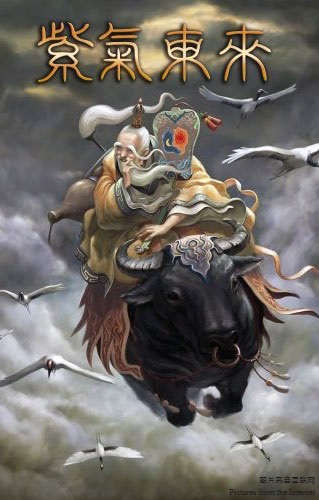Tai Shang Lao Jun / Daode Tianzun (道德天尊)
Daode Tianzun (道德天尊) is the official title for Tàiqīng (太清): the Grand Pure One, which is one of the Three Pure Ones. He is commonly known as Taishang Laojun (太上老君) “The Grand Supreme Elderly Lord”. His other names include Daode Zhizun 道德至尊 “The Universally Honoured Virtuous One”, Daojiao Zhizu (道教之祖), the Taoist Ancestor. Laozi is regarded to be a manifestation of Daode Tianzun who authored the classic Tao Te Ching.
The Tao Te Ching, along with the Zhuangzi, is a fundamental text for both philosophical and religious Taoism, and strongly influenced other schools, such as Legalism, Confucianism, and Chinese Buddhism, which when first introduced into China was largely interpreted through the use of Daoist words and concepts. Many Chinese artists, including poets, painters, calligraphers, and even gardeners, have used the Daodejing as a source of inspiration. Its influence has also spread widely outside East Asia, and is among the most translated works in world literature.
The Tao Te Ching has a long and complex textual history. On one hand, there are transmitted versions and commentaries that date back two millennia; on the other, there are ancient bamboo, silk, and paper manuscripts that archeologists discovered in the last century.
Dao 道
Dào/tao literally means “way”, or one of its synonyms, but was extended to mean “the Way.” This term, which was variously used by other Chinese philosophers (including Confucius, Mencius, Mozi, and Hanfeizi), has special meaning within the context of Taoism, where it implies the essential, unnamable process of the universe.
Dé/te means “virtue”, “personal character,” “inner strength” (virtuosity), or “integrity.” The semantics of this Chinese word resemble English virtue, which developed from virtù, a now-archaic sense of “inner potency” or “divine power” (as in “healing virtue of a drug”) to the modern meaning of “moral excellence” or “goodness.” Compare the compound word taote (Chinese: 道德; pinyin: Dàodé; literally: “ethics”, “ethical principles,” “morals,” or “morality”).
Jīng/ching as it is used here means “canon,” “great book,” or “classic.”
Thus, Tao Te Ching can be translated as “The Classic of the Virtuous Way.”
The title Daodejing is an honorific given by posterity, other titles include the amalgam Lǎozǐ Dàodéjīng (老子道德經), the honorific Daode Zhen Jing (道德真經 “True Classic of the Way and the Power”), and the Wuqian wen (五千文 “Five thousand character [classic]”).
The received Tao Te Ching is a short text of around 5,000 Chinese characters in 81 brief chapters or sections (章). There is some evidence that the chapter divisions were later additions–for commentary, or as aids to rote memorization–and that the original text was more fluidly organized. It has two parts, the Tao Ching (道經; chaps. 1–37) and the Te Ching (德經; chaps. 38–81), which may have been edited together into the received text, possibly reversed from an original “Te Tao Ching.” The written style is laconic, has few grammatical particles, and encourages varied, even contradictory interpretations. The ideas are singular; the style poetic. The rhetorical style combines two major strategies: short, declarative statements and intentional contradictions. The first of these strategies creates memorable phrases, while the second forces us to create our own reconciliations of the supposed contradictions.
The Chinese characters in the original versions were probably written in zhuànshū (篆書 seal script), while later versions were written in lìshū (隸書 clerical script) and kǎishū (楷書 regular script) styles. Daoist Chinese Characters contains a good summary of these different calligraphies.
Laozi was now capable of incarnating himself, almost like Buddhist bodhisattvas. Not long thereafter he joined the triad of the Three Pure Ones, and finally Laozi emerged as the chief divine person. We have here one of the more interesting examples of apotheosis, or deification, in the history of religion.
It is believed that Daode Tianzun manifested himself in the form of Laozi. Daode Tianzun is also the treasurer of spirits, known as the Lord of Man who is the founder of Taoism. He is the most eminent, aged ruler, which is why he is the only Pure One depicted with a pure white beard.
According to Daozang, Daode Tianzun had manifested many various incarnations to teach living beings, and Laozi is one of his incarnations.

